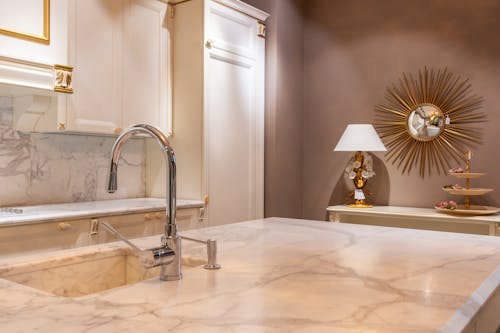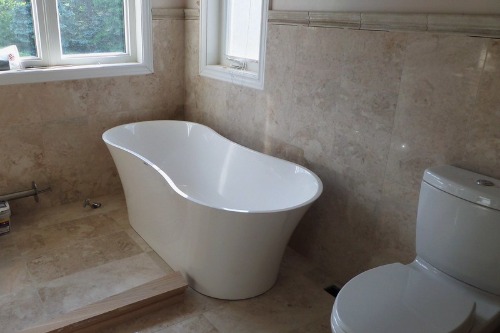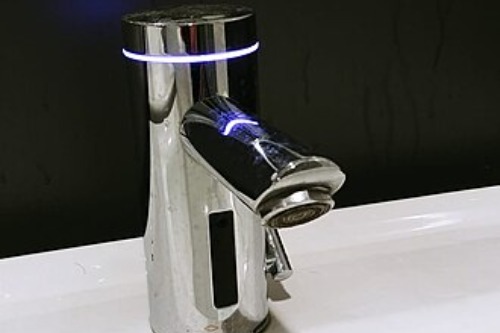1. Open Shelving in the Kitchen

Open shelving looks stunning in design magazines—everything is airy, minimalist, and perfectly curated. But in real life, it’s hard to keep those shelves looking neat unless you’re super disciplined. Everyday items like mismatched mugs, canned goods, or stained plastic containers don’t exactly scream “aesthetic.” Plus, dust and grease from cooking settle on everything, so you’ll be cleaning dishes you haven’t used.
What starts as a stylish choice quickly becomes a maintenance headache. Closed cabinets might not have the same Pinterest appeal, but they hide clutter and cut down on cleaning. If you cook regularly, open shelving can feel more like a burden than a bonus. It’s form over function, and the function often loses.
2. High-Maintenance Countertops (Like Marble)

Marble countertops are gorgeous, no question. But they’re incredibly porous, which means they stain easily and can etch from even mildly acidic substances like lemon juice or vinegar. One careless moment while making a salad, and you’re left with a permanent reminder. Not ideal if your kitchen doubles as a battleground of daily life.
You’ll constantly worry about red wine spills or coffee rings, which turns cooking into a stress-fest. Marble requires regular sealing and gentle cleaners, not just a quick wipe-down. If you’re not ready to babysit your counters, you’ll probably regret the decision. Quartz or granite might not look as luxe, but they’re much more forgiving.
3. Freestanding Bathtubs

Freestanding tubs are a favorite in modern luxury bathrooms—they evoke spa vibes and look amazing in photos. But they can be difficult to use in everyday life, especially for families or anyone with mobility issues. There’s often no ledge to store soap or shampoo, so you’re constantly reaching awkwardly or using clunky caddies. And cleaning around and underneath them? A total pain.
They also tend to be less insulated, so the water doesn’t stay warm for long. If the tub is placed far from a wall, the plumbing can be exposed or oddly positioned, adding both aesthetic and logistical complications. Installation costs can also be higher due to floor reinforcement. Unless you take frequent, meditative baths, the fuss might outweigh the flair.
4. Wall-Mounted Faucets

Wall-mounted faucets offer a sleek, modern look that instantly upgrades the vibe of any bathroom or kitchen. But they’re tricky to install, requiring very precise plumbing placement inside the wall. If anything goes wrong—leaks, mineral buildup, or just a need to tighten a connection—you may need to open up the wall. That’s not something you want to deal with after moving in.
Cleaning the wall behind the faucet can also be more annoying than you’d think, especially if it’s tile with grout lines. And if you ever decide to swap out the sink, your options are limited by the faucet height and placement. They’re cool to look at, but definitely a long-term commitment. For most people, a countertop fixture is way less stress.
5. Sliding Barn Doors

Barn doors bring a rustic-chic charm that’s become hugely popular thanks to shows like Fixer Upper. But they don’t seal tightly, so they’re terrible for soundproofing and privacy—especially problematic for bathrooms or bedrooms. They also require a fair amount of wall space to slide open, which limits how you can arrange furniture. Plus, the exposed tracks can collect dust and are sometimes noisy to operate.
They’re also surprisingly heavy and can be tricky for kids or older adults to maneuver. Because they sit off the wall, light and noise often creep in from the sides. You may love how they look, but don’t count on them to function like a traditional door. They’re more about style than practicality.
6. Floor-to-Ceiling Windows

Massive windows create a stunning, light-filled space that makes your home feel bigger and more modern. But they also come with heat loss in winter, heat gain in summer, and sky-high energy bills if they’re not properly insulated. You’ll probably need special window treatments to control glare and privacy, which can be expensive and hard to clean. And don’t forget about birds—big windows increase the risk of collisions.
Cleaning them is another ordeal, especially on upper floors. You’ll either need special equipment or hire professionals. And unless you’re totally fine with neighbors (or strangers) seeing inside, you might constantly feel like you’re on display. They look amazing, but they come with a hefty list of trade-offs.
7. Touchless Faucets

Touchless faucets seem like a high-tech convenience, perfect for messy cooking or minimizing germ spread. But they’re surprisingly finicky—you often have to wave your hands around to get the water flowing, and they don’t always respond correctly. Batteries need regular changing, or they just stop working altogether. And if there’s a power outage and your backup isn’t manual, you’re stuck.
They’re also more expensive to install and repair than traditional faucets. Kids might think they’re toys, leading to unnecessary water usage or messes. For some people, the extra technology just complicates a simple task. Unless you really need hands-free function, a well-designed manual faucet does the job better.
8. All-White Interiors

All-white interiors feel clean, timeless, and elegant—but only in theory. In practice, white walls, floors, and furniture show every scuff, stain, and fingerprint. Daily life brings color and chaos, and an all-white space magnifies every bit of it. You’ll find yourself constantly wiping things down or stressing over wear and tear.
This setup can also feel sterile or cold unless you balance it with lots of textures and warm accents. Pets, kids, and red wine are basically public enemies number one in an all-white home. Unless you love cleaning or rarely use the space, it’s a tough aesthetic to maintain. It’s beautiful, yes—but definitely high-maintenance.
This post 8 Home Upgrades That Look Good in Theory but Complicate Daily Life was first published on Greenhouse Black.
